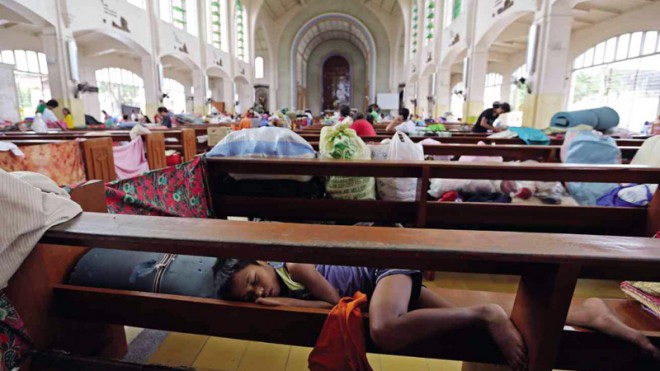Harvard survey: Filipinos believe homes, farming, kids most at risk to disasters

REFUGE IN THE HOUSE OF GOD A child uses a pew as a makeshift bed inside the Redemptorist Church in Tacloban City where residents evacuated ahead of the landfall of Typhoon “Ruby” (international name: Hagupit) in 2014 in the Visayas. The typhoon threatens to whip up storm surges in the disaster-weary central Philippines that was flattened by Supertyphoon “Yolanda.” INQUIRER file photo / RAFFY LERMA
MANILA, Philippines — Majority of Filipinos believe that homes, farming, and children are the most vulnerable to disasters in the Philippines, a Harvard survey revealed.
The nationwide household survey was conducted between March and April of 2017 by the Harvard Humanitarian Initiative (HHI) Program on Resilient Communities (PRC) with 4,368 adult respondents representing all economic strata.
“This information is important for DRRM (Disaster Risk Reduction and Management) officials to consider as they mull over the kind of messaging and training they develop to better prepare for future disasters,” HHI PRC program director Vincenzo Bolletino said.
Most vulnerable infrastructure
According to the survey, 69 percent of Filipino households believe that their homes “were at most risk during a disaster” among all the assets they owned.
Article continues after this advertisementThirty-two percent said that farmland was the most vulnerable to disasters, 23 percent said roads are at most risk while 15 percent answered schools.
Article continues after this advertisementThe survey noted that “only a small part” of the respondents were concerned about fishing resources with 13 percent, bridges with 11 percent, water, sanitation and hygiene facilities with eight percent, and health facilities with five percent.
According to the survey, Filipinos’ high concern over their homes “may be linked to their experience with disasters, as most of the population have experienced significant damage to property, assets and have been displaced from their homes due to a disaster.”
Forty-two percent of Filipinos have reported that their homes were partially destroyed while 16 percent had been displaced for at least a week, the survey added.
“The high level of damage to homes was particularly pronounced in Eastern Visayas, the region extremely hit by Typhoon Haiyan (Yolanda), where 97 percent of homes have either been partially damaged or completely destroyed at some point by a disaster,” the HHI PRC said.
“The region also reported the highest level of vulnerability of homes at 84 percent, followed by the National Capital Region (NCR) at 82 percent,” it noted.
The survey also said that the homes of most Filipinos were unprotected to losses and damages with only three percent had some form of home insurance.
Most vulnerable workers
Further, the survey also found that 57 percent of Filipinos believe that farmers were the most vulnerable workers to disasters in the country.
Meanwhile, 39 percent said that fishermen and wage laborers were the most at risk followed by shopkeepers or businessmen with 13 percent and livestock herders with 12 percent.
Cagayan Valley, which has the most of the population dependent on farming reported the highest level of vulnerability of farmers at 87 percent.
Meanwhile, the National Capital Region (NCR), the region with the most skilled salaried workers, cited the highest level of vulnerability of wage laborers at 82 percent.
Most vulnerable people
The survey found that more than half of the respondents, or 52.3 percent, believe that children are the most vulnerable to disasters.
This was followed by the elderly at 51.9 percent, poor people at 35 percent, and people with disabilities at 23 percent.
According to the survey, the NCR and the newly established Bangsamoro Autonomous Region in Muslim Mindanao (BARMM) reported the highest level of children’s vulnerability, both at 72 percent.
BARMM also reported the highest concern over the elderly at 72 percent, followed by NCR at 68 percent.
“Undeniably, the Philippines has numerous vulnerable populations. A quarter of the population are living below the national poverty level, and there are huge numbers of informal settlements in coastal/flood prone areas, especially in Metro Manila,” the HHI PRC said.
“Furthermore, the population is also still largely young with a third of it below 14 years, while over a million people are displaced each year due to rapid-onset disasters,” it added. /jpv
RELATED STORY:
Most Filipinos believe not being ready for disasters — Harvard study